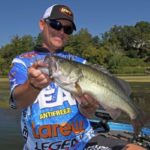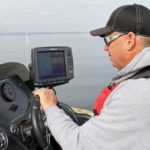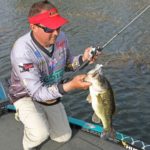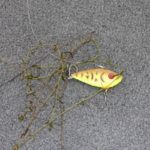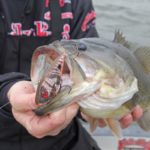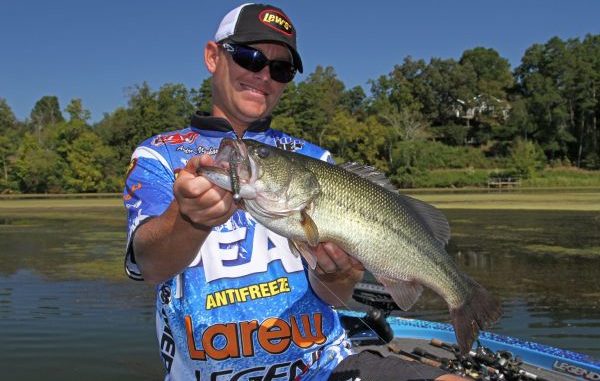
Find grass and you’ll find prespawn sweet spots that hold big bass waiting to move up. Here are some pro thoughts on how to leverage that information.
Grass equals bass — yep, we got that. But getting to know the specific makeup of vegetation is essential, especially during the early spring before the it grows tall and thick.
Anglers seeking prespawners find that the combination of grass height, contour and density plays a key role in fish positioning. Water clarity also factors here, and the amount of grass an area has sprouted can greatly impact how quickly waters clear after a muddy runoff from spring rains.
Bass anglers like FLW Rayovac Series pro Phil Marks are so picky about knowing grass features that some complement the high-def displays of their split screen sonar units with an old-school flasher, which provides critical insight into how high the vegetation is growing, where contour points are located, and where any holes and caverns might be forming.
“The Vexilar (flasher) is real time, and it doesn’t matter how fast I’m going or if I get into any prop water, I can still see pretty good,” Marks said.
Noting that he’ll use both his Vexilar and his Lowrance HDS-10 to view the grass, Marks said turning down the latter’s sensitivity allows him to actually peek into the grass to identify the points, the edges, the caverns and all those little hidey holes that bass use. When the sensitivity is set too high, the grass typically just blacks out the screen, and you sacrifice valuable perspective on fish positioning.
During early spring outings on Toledo Bend, I’ve watched Marks idle shallow bays near spawning flats with his eyes glued to his sonar screen like a Wall Street broker watching a bull market stock ticker. For him, the spikes and dips were far less stressful than those of any financial district charts — in prespawn scouting missions, he actually wants to see prominent variances in his bottom returns.
That’s where the fish are.
Here’s how he deciphers and uses that information to build heavy stringers.
High-value targets
Grass is grass, but where grass is located matters in terms of its potential.
Marks said he wants to see grass sprouting around humps, drains, points and clean spots. Remember, prespawners want to set up close to where they’ll actually spawn, so clean, hard bottom should be in close proximity to the new growth.
Mark’s fellow Toledo Bend competitor Russell Cecil also has a strategic view of grass.
“I think of grass as cover, so I look for the same things as I would without grass,” Cecil said. “I look for migration routes, channels and irregularities to congregate fish.
“After finding a likely area, I probe the corners, ends of grass lines and edges.”
Now, one might think that, in terms of grass density, more is better. Later in the year that’s probably the case more often than not.
However, during the prespawn period, when those big mama bass get bad cases of temperamental moodiness, they can become pretty particular about where they stage.
That’s not to say you won’t find a bunch of these girthy gals packed into a good patch of grass — in fact, it stands to reason that more-favorable habitat should hold more opportunity.
Nevertheless, Cecil said he’s done well by investing a little extra effort into scoping out a handful of spots well away from the obvious.
“One thing that has been successful for me is finding isolated clumps of grass with my Humminbird side imaging,” he said.
Marks agreed, noting that the heavy pressure of spring tournaments can quickly scatter fish. So, while the masses commonly gravitate toward areas of heaviest grass growth, those who spend a little more time locating the less-obvious stuff are often rewarded with a big bite or two.
Find the good stuff
When eyeballing the vegetation below, Marks said he’s on the lookout for grass with a good vertical profile.
“You can tell if it’s standing up or if it’s lying down like a smudge, not too high off the bottom,” Marks said. “They will get on that smudge, if that’s all there is, but typically you want tall, crispy grass that’s standing up. This is usually identifiable on your Vexilar or sonar.”
So what’s so special about the grass with good posture?
“I think that with the crisp, live grass you have the whole circle of life working there,” Marks explained. “That time of year, it’s not really about shad — it’s more crawfish, bream and perch. I feel like when the grass is healthy and alive everything else is there, too, and, hence, the bass will be there.
“The grass that’s laying down is typically dead or dying. Also, when it’s laying down, it can disappear overnight — a big wind and it’s gone.”
It’s also worth noting that Marks has a real love/hate relationship with coots. On one hand, these grass nibblers always find vegetation, so a raft of these black-feathered pooping machines is a good sign of promising prespawn waters.
Conversely, coots are probably the least-preferred method of grass location because they tend to rip up stalks of hydrilla and leave a floating snag hazard littering the area. That’s not necessarily a day-wrecker, but it’s certainly something to consider when selecting baits.
Baits and tackle
For the grass game, Cecil likes crankbaits of various sizes, depending on the depth he’s fishing. Ticking the tops of the grass and reaching down to the inside edge is important for tempting the big ones.
“I use a lipless bait quite often, but I’ll use a bait with a bill if the grass is deeper than 3 to 4 feet,” Cecil said.
Marks also follows a similar plan: He’s a big fan of “machine-gunning” an area with a Strike King Redeye Shad lipless crankbait to search for active fish.
Snagging the edges of grass and ripping the bait free is a tried-and-true tactic for enticing prespawners.
In deeper water, Marks might use a Strike King Series 5 crankbait, while Strike King’s new KVD 8.0 can really come into play in deeper prespawn grass stuff. This big-bodied squarebill can be particularly effective if the fish are sitting over grass tops on sunny days.
For probing into the grass, Marks ties on a ½- to ¾-ounce Strike King Denny Brauer Structure Jig with a bulky trailer and drags along the sandy bottom. The String King Rage Craw is his first trailer choice, and he’ll bite a half inch off the head to make the profile more compact.
If he senses that fish don’t want an active trailer, he’ll go with the finesse look of a Strike King Menace Grub, which is also his choice in deeper water where a streamlined profile is essential for quickly getting his jig down to the fish.
